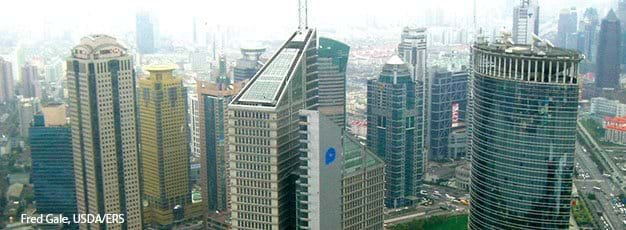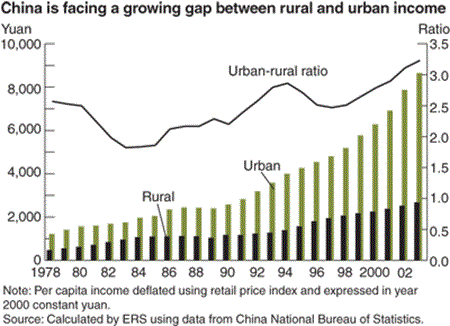China's Economic Growth Faces Challenges

Few other countries have been able to match the pace of China's sustained economic growth. With gross domestic product (GDP) increasing, on average, more than 8 percent annually since 1978, China has become a major player in the global economy. In the long term, however, this extraordinarily high GDP growth—which is driving China's increasing demand for agricultural imports—may be dampened by several obstacles:
In the long term, however, this extraordinarily high GDP growth—which is driving China's increasing demand for agricultural imports—may be dampened by several obstacles:
- Undervalued currency. China's exports rely on what may be an unsustainably low fixed exchange rate. China has maintained its currency at a fixed rate of approximately 8.28 yuan per U.S. dollar since 1997, a rate that some economists suggest is undervalued by as much as 40 percent. There is substantial international political pressure on China to appreciate its currency. Any significant appreciation of the yuan would reduce China's export competitiveness and slow down the growth of China's exports, a major factor in China's rapid economic growth.
- Nonperforming bank loans. China's banking system has historically made loans under government direction to unprofitable state-owned industries, with little regard for repayment or risk. The result is a substantial portfolio of nonperforming loans estimated at 30 to 100 percent of annual GDP, a larger share than that of Japan, for example. By using its stock of foreign reserves, Chinese authorities have managed to maintain liquidity in the banking system in spite of the nonperforming loans. However, at some point a continued escalation of nonperforming loans will restrict further expansion of bank credit, constraining growth in the business sector.
- Growing income disparities. In 2003, urban per capita income was more than three times the rural average, up from twice the rural average during the 1980s. In 2000, China embarked on a 'develop the west' campaign to push both public and private investment into the country's poorest western provinces. While this campaign should help reduce income disparities, it will take resources away from the most productive export manufacturing sector, reducing overall growth.
- Inefficient state-owned enterprises (SOEs). SOEs consume much of China's capital through their historical links to the state banks and dominance of the stock exchange in China, but they produce little or no return on their capital. Many are poorly managed and protected from competition. Private enterprises are more efficient, but have difficulty raising capital. Many SOEs have been shut down or merged with stronger enterprises, but fears of exacerbating already-serious unemployment problems are a constraint as China shifts resources to the private sector.
Rapid economic growth is a major factor contributing to China's increasing importance as an agricultural export market. A significant slowdown in that growth would reduce China's demand for U.S. agricultural products, including soybeans, cotton, wheat, and corn. Even so, China will likely continue to be a major destination for U.S. agricultural exports.
China: A Study of Dynamic Growth, by Mathew Shane and Fred Gale, USDA, Economic Research Service, October 2004


